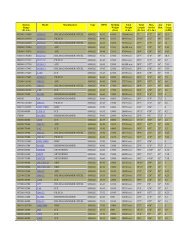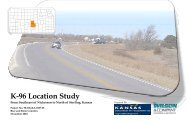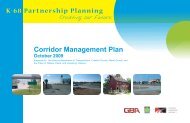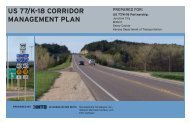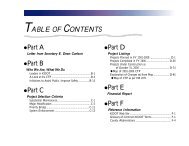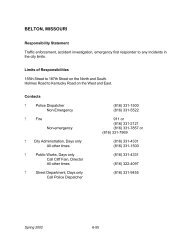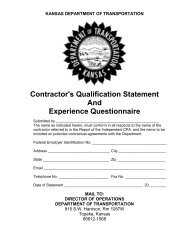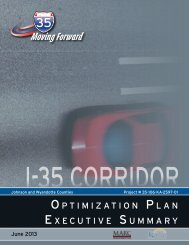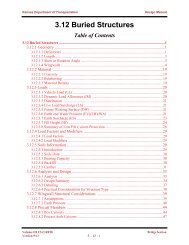KANSAS MOTOR VEHICLE ACCIDENT REPORT CODING MANUAL
KANSAS MOTOR VEHICLE ACCIDENT REPORT CODING MANUAL
KANSAS MOTOR VEHICLE ACCIDENT REPORT CODING MANUAL
You also want an ePaper? Increase the reach of your titles
YUMPU automatically turns print PDFs into web optimized ePapers that Google loves.
<strong>ACCIDENT</strong> PHOTOGRAPHS<br />
An important part of traffic crash investigation is recording information so that it can be used later.<br />
Photography is an indispensable means of recording certain kinds of traffic crash information and a<br />
useful supplement to the traffic crash report and diagram. Photos are employed in two ways to<br />
preserve information:<br />
a. As a permanent, accurate unbiased record of something specifically observed by an<br />
investigator.<br />
b. To capture the detailed appearance of something such as a mark on the road or damage to a<br />
vehicle, which may later reveal significant details that were not observed at the time the picture<br />
was taken.<br />
As a record of observations, photos serve…<br />
1) To recall later to an investigator’s mind details of what he saw, and<br />
2) To explain what the investigator saw to someone else, perhaps in court. A dozen pages, which<br />
could take hours to write, cannot describe details of damage to a vehicle as well as a single<br />
picture. The nature of scratches on a vehicle’s body, or the pattern of fractures in a windshield<br />
defy accurate description in words.<br />
As a reservoir of nondescript information, photos include unnecessary data and may omit essential<br />
facts because the photographer was unaware of those facts when the photo was made. However,<br />
photos made on the chance that they might prove useful to include an immense amount of data<br />
that would otherwise be unavailable. Moreover, photos made only to record an investigator’s<br />
particular observations often also include a wealth of detail not noticed by the investigator at the<br />
time he made the photograph.<br />
Uses of photographs<br />
Credibility of photos is impressive. People tend to believe that “photos don’t lie.” Although a photo<br />
may not be completely “true representation,” it is regarded as relatively free from the bias that may<br />
influence verbal or written reports. Photos are certainly not subject to the loss of detail and<br />
uncertainties that memory is. Hence, photos are very effective in verifying reports of observations.<br />
Photos are unsurpassed in offering the officer a reminder to refresh the memory about something<br />
seen in the past, perhaps years ago.<br />
Writing and sketching are simplified by making photos. Often a photograph makes notes of<br />
observations unnecessary. A spare print of a photograph can be marked with notes giving<br />
dimensions, pointing out significant observations, and explaining why the photo was made. Do<br />
this as soon as you receive the print of the picture. This makes the photo more effective in<br />
reminding you of what you observed. Such a marked photo cannot ordinarily be admitted as<br />
evidence in court, but it may be referred to like any other notes you have made. It is useful to mark<br />
each photo of a traffic crash scene with a small arrow to show which direction is north.<br />
If the crash is later sent to a reconstructionist, photographs are very helpful to bring the<br />
reconstructionist to the scene. Sometimes details that the investigating officer did not observe or<br />
note will be evident to the trained professional. It may allow the reconstructionist a chance to<br />
follow up with the investigator or witness in dissecting this crash further.<br />
Copies of documents made photographically by one process or another are frequently used in<br />
traffic crash investigation. The most commonly copied document is the official traffic crash report<br />
form.<br />
When to make photographs<br />
The point in the investigation at which to make photos depends on how urgent photographic<br />
documentation is compared to other procedures. For example, if there are no injuries, but<br />
86



